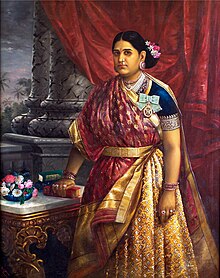History
The Order of the Crown of India was established by Queen Victoria in 1878 as a companion order to the Order of Victoria and Albert. The order was intended to recognize women associated with India regardless of their social statuses. In practice, the Order of the Crown of India was mostly conferred on royalty, wives of peers, wives of members of India's ruling classes and wives of civil servants stationed in India. It is one of the few honors which was reserved for women only, such as the Order of Victoria and Albert and the Royal Family Order.
Queen Elizabeth II, then Princess Elizabeth, and her sister, Princess Margaret, were appointed to the Order by their father, King George VI, in June 1947, before the British Raj was dissolved three months later, making them among the last women to be presented with the Order. By the late 20th century there were only four living recipients – Queen Elizabeth II, Queen Elizabeth the Queen Mother, Princess Margaret, and Princess Alice, Duchess of Gloucester, who was the last ordinary member at the time of her death in 2004.
With the death of the last surviving holder, Queen Elizabeth II, the last active imperial Indian order became dormant in 2022.
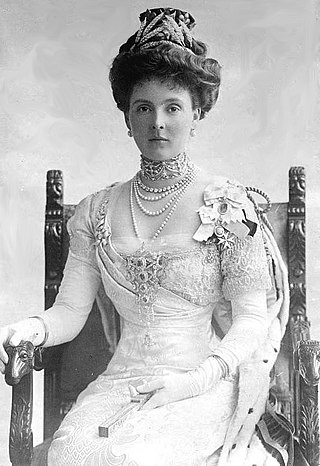
Princess Alice, Countess of Athlone was a member of the British royal family. She was one of the longest-lived British royals. Princess Alice was the chatelaine of Rideau Hall in Ottawa from 1940 until 1946, while her husband Alexander Cambridge, 1st Earl of Athlone, served as Governor General of Canada.

Princess Augusta of Cambridge was a member of the British royal family, a granddaughter of George III. She married into the Grand Ducal House of Mecklenburg-Strelitz and became Grand Duchess of Mecklenburg-Strelitz.
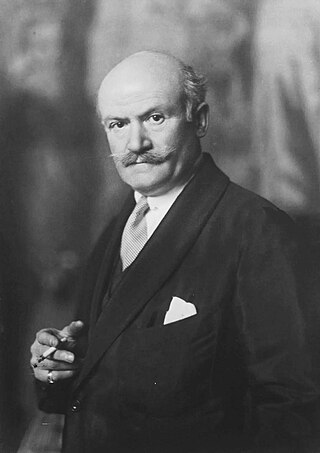
Philip Alexius László de Lombos, known professionally as Philip de László, was an Anglo-Hungarian painter known particularly for his portraits of royal and aristocratic personages. In 1900, he married the Anglo-Irish socialite Lucy Guinness, and he became a British subject in 1914. László's patrons awarded him numerous honours and medals. He was invested with the Royal Victorian Order by Edward VII in 1909 and, in 1912, he was ennobled by Franz Joseph I of Austria; becoming a part of the Hungarian nobility.

The Most Eminent Order of the Indian Empire is an order of chivalry founded by Queen Victoria on 1 January 1878. The Order includes members of three classes:
- Knight Grand Commander (GCIE)
- Knight Commander (KCIE)
- Companion (CIE)
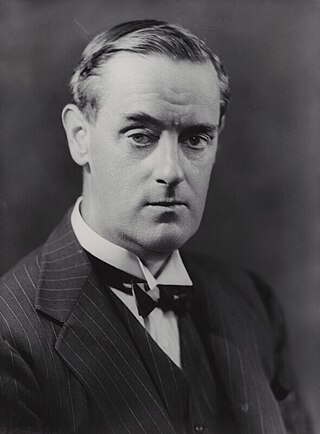
Victor Alexander John Hope, 2nd Marquess of Linlithgow, was a British Unionist politician and statesman, agriculturalist, and colonial administrator. He served as Governor-General and Viceroy of India from 1936 to 1943. He also served as vice president of the Royal Society of Edinburgh, Chancellor of the University of Edinburgh and Lord High Commissioner to the General Assembly of the Church of Scotland. He was usually referred to as LordLinlithgow, or simply Linlithgow.

Edwina Cynthia Annette Mountbatten, Countess Mountbatten of Burma, was an English heiress, socialite, relief worker and the last vicereine of India as the wife of Rear Admiral The 1st Viscount Mountbatten of Burma.

Arthur Oliver Villiers Russell, 2nd Baron Ampthill, was a British peer and civil servant. He served as Governor of Madras from October 1900 to February 1906, and as acting Viceroy of India from April to December 1904.
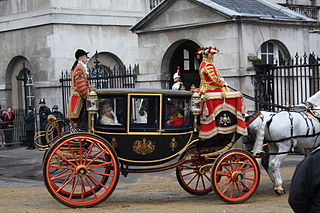
Lady of the Bedchamber is the title of a lady-in-waiting holding the official position of personal attendant on a British queen regnant or queen consort. The position is traditionally held by the wife of a peer. A lady of the bedchamber would give instructions to the women of the bedchamber on what their queen wished them to do, or may carry out those duties herself.
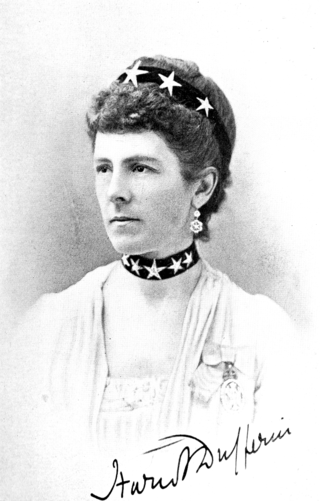
Hariot Georgina Hamilton-Temple-Blackwood, Marchioness of Dufferin and Ava, was a British aristocrat and Vicereine of India, known for her success in the role of "diplomatic wife," and for leading an initiative to improve medical care for women in British India.

The Royal Burial Ground is a cemetery used by the British royal family. Consecrated on 23 October 1928 by the Bishop of Oxford, it is adjacent to the Royal Mausoleum, which was built in 1862 to house the tomb of Queen Victoria and Prince Albert. The burial ground lies on the Frogmore estate within the Home Park at Windsor, in the English county of Berkshire.
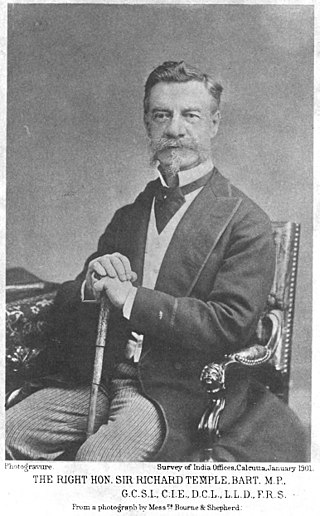
Sir Richard Temple, 1st Baronet, was a British colonial administrator in the 19th-century India, who served as Governor of Bombay from 1877 to 1880.
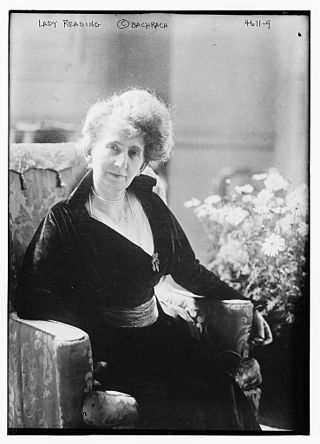
Alice Edith Isaacs, Marchioness of Reading, was the first wife of Rufus Isaacs, 1st Marquess of Reading, and a prominent philanthropist in colonial India. Her husband served as Viceroy and Governor-General of India, making her the Vicereine of India.
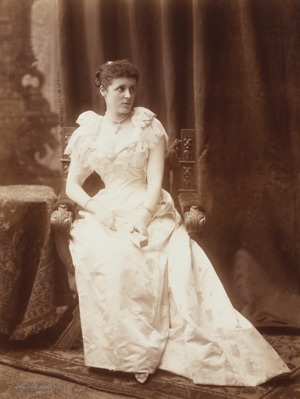
Hersey Alice Hope, Marchioness of Linlithgow was a British aristocrat, who was the wife of John Hope, 1st Marquess of Linlithgow, who, as the 7th Earl of Hopetoun, was the first Governor-General of Australia 1901 – 1903.

Winifred Selina Hardinge, Baroness Hardinge of Penshurst, CI was a British aristocrat, courtier and Vicereine of India.
The Countess of Dufferin Fund was established by Hariot Hamilton-Temple-Blackwood, Marchioness of Dufferin and Ava, more commonly known as Lady Dufferin, in 1885 and was dedicated to improving women's healthcare in India. The Fund was founded after Queen Victoria gave Lady Dufferin the task of improving healthcare for women in India. The Fund provided scholarships for women to be educated in the medical field as doctors, hospital assistants, nurses, and midwives. It also financed the construction of female hospitals, dispensaries, and female only wards in preexisting hospitals. The Fund marks the beginning of Western medicine for women in India and global health as a diplomatic concern.

Edith Bulwer-Lytton, Countess of Lytton, was a British aristocrat. As the wife of Robert Bulwer-Lytton, 1st Earl of Lytton, she was vicereine of India. After his death, she was a court-attendant of Queen Victoria. Her children included suffragette Constance Bulwer-Lytton.
The 1866 Birthday Honours were appointments by Queen Victoria to various orders and honours to reward and highlight good works by citizens of the British Empire. The appointments were made to celebrate the official birthday of the Queen, and were published in The London Gazette on 25 May and 29 May 1866.
The 1884 Birthday Honours were appointments by Queen Victoria to various orders and honours to reward and highlight good works by citizens of the British Empire. The appointments were made to celebrate the official birthday of the Queen, and were published in The London Gazette in May and June 1884.
The 1911 Delhi Durbar was held in December 1911 following the coronation in London in June of that year of King George V and Queen Mary. The King and Queen travelled to Delhi for the Durbar. For the occasion, the statutory limits of the membership of the Order of the Star of India and the Order of the Indian Empire were increased and many appointments were made to these and other orders. These honours were published in a supplement to the London Gazette dated 8 December 1911.

The wedding of Albert Edward, Prince of Wales, and Princess Alexandra of Denmark took place on 10 March 1863 at St. George's Chapel, Windsor Castle. It was the first royal wedding to take place at St. George's, and the last wedding of a Prince of Wales until Prince Charles and Lady Diana Spencer's 1981 wedding.



